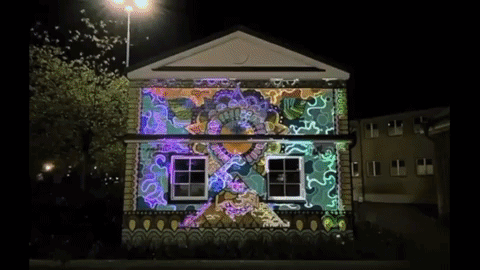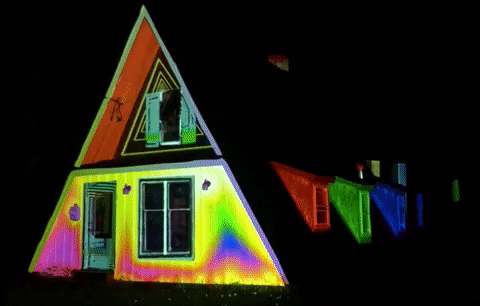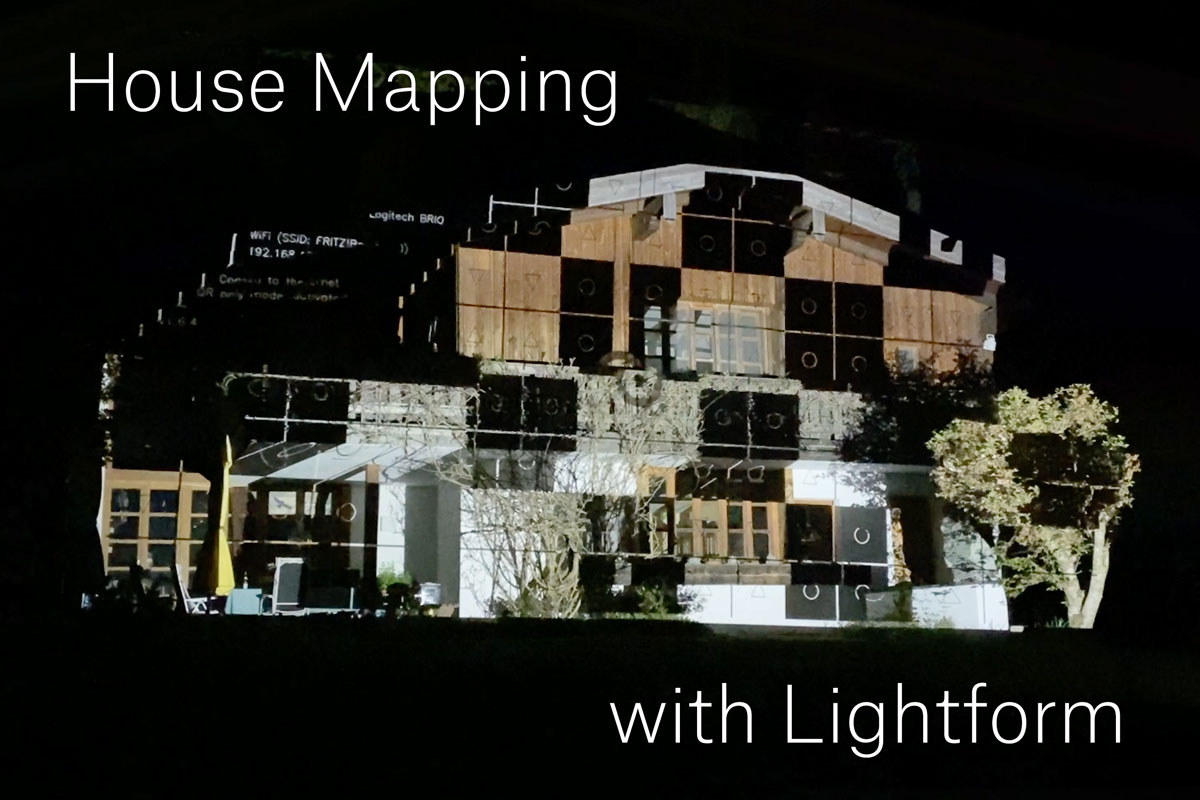House mapping, using a projector in combination with image mapping software to illuminate a house, is a popular topic of Lightform customers. Our team is often asked “Can I map my house with Lightform?” and the answer is, “Yes, you can.” Lightform streamlines the process to create immersive displays to decorate your home and showcase your design skills.
In this blog post, we will discuss house mapping best practices and recommendations when using Lightform. Several Lightform customers have created noteworthy house mapping examples, using a variety of projectors across the spectrum of house sizes, that we’ll highlight below. Lastly, you’ll find useful resources and articles to help you create a successful house mapping experience of your own.
Which Lightform Unit To Use?
When it comes to projection mapping a house with Lightform, pairing the Lightform LFC Kit with a powerful projector is recommended. Utilizing a projector that will be bright enough to display projections from a distance is important to consider. This holds true for all large-scale projection-mapping installations. If curious to the differences between the LFC Kit and LF2 AR projector we recommend reading: Lightform LFC Kit vs. LF2 – Choosing the Right Tool for the Right Job.
House Mapping Tips & Recommendations
Lorem ipsum dolor sit amet, consectetur adipiscing elit. Ut elit tellus, luctus nec ullamcorper mattis, pulvinar dapibus leo.

House mapping by Joel Dittrich.
Bright (high-lumen) projectors are ideal to use with the LFC Kit for house mapping. A projector with a minimum of 3,000 lumens is a good starting point for a single-story house. A brighter projector >5,0000 lumens is recommended for projecting on larger homes.
What are Lumens?
Lumens are a unit that measures the total amount of visible light from a lamp or light source. Projector brightness is measured in lumens. The higher the lumen rating, the brighter the light source will appear. In short, more lumens equals more light. The official name for projector lumens is ANSI lumens (ANSI being short for American National Standards Institute.) As an example, home theatre projectors usually emanate between 1500-3000 lumens.
- Bright (high-lumen) projectors are ideal to use with the LFC Kit for house mapping. A projector with a minimum of 3,000 lumens is a good starting point for a single-story house. A brighter projector >5,0000 lumens is recommended for projecting on larger homes.
- An optimal position for the LFC Kit and projector is an important consideration when setting up your scene. There are a few things that will determine what that optimal position will be, or what projector will work best in your space.
- Dimensions of the area of the house you want to project onto should be measured. Keep in mind that the larger that area is, the more lumens you will need to achieve a bright projection. Similarly, the larger the area is, the larger the individual pixels will be in your projection, so you’ll want at least 1080p resolution, if not 4k, to maintain clarity and detail.
- Throw ratio and aspect ratio of the projector will help you determine the distance between your projector and your house to achieve the scale you want. Throw Ratio is the distance between the projector and the frame divided by the projected frame’s width.
Throw Ratio = Throw Distance / Image Width
The lower the throw ratio is, the closer the projector can be, the higher it is, the further the projector can be. LFC supports throw ratios between 0.5:1-2.0:1. The aspect ratio is the relation of the projected frame’s width to the projected frame’s height. The majority of projectors have an aspect ratio of 16:9, like a widescreen monitor or TV, but some have 4:3 aspect ratios. If your house is close to being as tall as it is wide, a 4:3 aspect ratio might be useful. - Throw distances and focal ranges are listed by projector manufacturers to help you determine where they can be positioned while calculating screen size. Like a camera lens, projector lenses cannot focus on everything at once. The throw distance will tell you how close and how far the limits of that focus will be. Unlike camera lenses, some projector lenses don’t focus to infinity, and there will be a maximum distance they can be before creating a blurry picture. The focal range will tell you how wide the area will be in focus at any given time. If your projector has a wider focal range, it will provide greater flexibility when placing your projector at an angle, allowing you to keep focus through a larger section of your projection’s entire depth.
- The alignment of the LFC Kit camera and the projector lens is an important part of any setup. The LFC camera must be able to see and properly focus on the entire subject. To get the best scan results, reference our Guide article Getting a Good Scan. Having a good scan of your house will make it easier to choose different surfaces and insert effects on the different areas in your scene.
Add Custom Animations & Video Loops
- Custom animations are supported including those generated with After Effects. To use custom animations render them to video and import them into Lightform Creator.
- Custom video loops can be downloaded and combined with the effects in Lightform Creator’s built-in library to create a memorable show. Customers have reported success using content on websites like pixabay or MotionLoops to create their custom loops.
How to Add Custom Content with Lightform Creator
Environmental Conditions

Cabin projections A-Frame by John Meehan. Made with LFC Kit + a Panasonic PT-VX500U (5,000 lumens)
Weather should be accounted for to ensure a positive experience when projecting outdoors. Lightform devices, like most projectors, are not waterproof. We advise caution when using them outside and we recommend taking safeguards to protect them. Projector enclosures are an option to protect your devices. If using an enclosure be sure there is proper ventilation for both the LFC Kit and the projector. The ideal operating temperature for the LFC is between 32°F – 86°F (0°C – 30°C).
The amount of light, whether from the sun or artificial lighting, can negatively impact the quality of the projection on a scene. Projecting in bright daylight or direct sunlight is not recommended. To get the best results wait for lower light levels during early evening hours or at night time. Keep an eye out for street lights as they might create unwanted shadows in your scene.
Beyond House Mapping Examples
The following examples highlight additional opportunities beyond house mapping, including projects covering gardens, terraces, pool houses, and more.
Mapping the Trees
Daelen Cory from L’Esperance Design used six LFC Kits to transform this client’s property into a mystical wonderland by mapping the trees and the grass around the house.
Pool House Mapping
Taylor Henson decided to turn his pool house into a cool house with projected AR and some funky mind-bending effects.
Mapping The Rose Garden
Luke Lee is a maker at Fusiform Design Workshop LLC. Before shelter in place started, he made sure to bring all the Lightform gear back to his house so he could map his rose garden.
What Will You Create?
With these best practices and recommendations, you should have an easier time house mapping and creating your own projected light-show. We look forward to seeing how you wow your audience and invite you to share house mapping experiences in the comments below.
If you’re on social media don’t hesitate to tag your videos #lightformcreations on Facebook, Instagram, and Twitter to have your work spotlighted on our blog and social accounts.
Note:
As of August 12th, 2022, Lightform is no longer in business and is no longer providing technical support for the product. Please refer to the Lightform Guide and FAQ for self-help resources.

